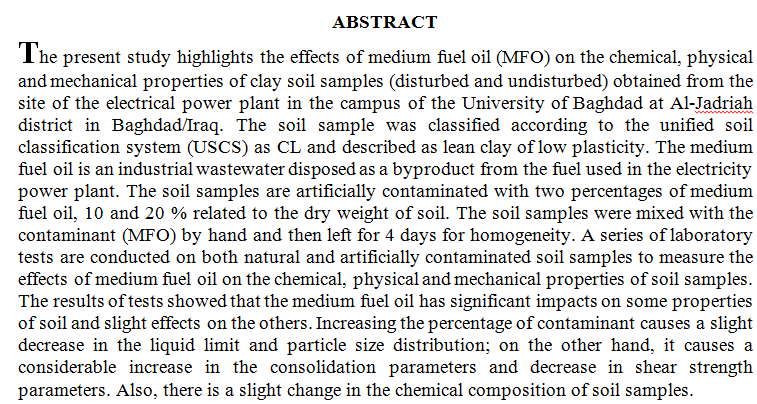
The study effect Graphene on optical and electrical properties of glass prepared on glass substrates using sol–gel dip-coating technique. The deposited film of about (60-100±5%) nm thick. Optical and electrical properties of the films were studied under different preparation conditions, such as graphene concentration of 2, 4, 6 and 8 wt%. The results show that the optical band gap for glass-graphene films decreasing after adding the graphene. Calculated optical constants, such as transmittance, extinction coefficient are changing after adding graphene. The structural morphology and composition of elements for the samples have been demonstrated using SEM and EDX. The electrical properties of films include DC electrical conductivity; we
... Show More (4)
(4)
This study was conducted to determine the activity of plant Sesbania rostrata and two isolate from arbuscular mycorrhizae fungi (A,B) as a bioremediation of soil polluted by cadmium and lead elements in north and south of Baghdad city. The results showed that the average of soil pollution by cadmium and lead elements in north of Baghdad was less than the average of soil pollution in the south of Baghdad which recorded 10.0, 9.0 mg/kg and 27.0, 25.0 mg/kg respectively. The plant Sesbania recorded ability to accumulate the lead element in shoot system 19.65 mg/kg and in root system 27.2 mg/kg and for cadmium element 19.6, 24.6 mg/kg in shoot and root respectively. The results showed that the isolate A from soil pollution is more effected
... Show MorePathogenic microorganisms from hospitals, communities, and the environment remain great threats to human health. The increasing concern about antibiotic resistance has also necessitated the search for robust alternatives. Therefore, this study aims to isolate, screen and evaluate the antibiotic susceptibility of Pseudomonas aeruginosa isolated from a soil sample taken from northern, western and eastern parts of Kelana Jaya Lake against four antibiotics (gentamycin, tetracycline, ampicillin, and penicillin) on a Mueller-Hinton Agar media plate. Pseudomonas identification was done by using API 20 kit. Disc diffusion was employed as well as the oxidase test. From the positive oxidase result, the isolated bacteria were identified as Burkhold
... Show More (9)
(9)
 (4)
(4)
Soil improvement has developed as a realistic solution for enhancing soil properties so that structures can be constructed to meet project engineering requirements due to the limited availability of construction land in urban centers. The jet grouting method for soil improvement is a novel geotechnical alternative for problematic soils for which conventional foundation designs cannot provide acceptable and lasting solutions. The paper's methodology was based on constructing pile models using a low-pressure injection laboratory setup built and made locally to simulate the operation of field equipment. The setup design was based on previous research that systematically conducted unconfined compression testing (U.C.Ts.). Th
... Show More (1)
(1)
In this study, the concentrations of uranium for four species of plants; Spinacia, Brassica Oleracea, BEASSICA Oleracea Var Capitata and Beta Vulgaris were measured in addition to the measurement of uranium concentrations in the selected soil by calculating the number of significant traces of alpha in CR-39. The 2.455 Bq/kg in Spinacia plant were the highest concentration while the lowest concentration of uranium were 1.91 Bq/kg in BEASSICA Oleracea Var Capitata plant. As for the transfer factor, the highest value 0.416 were found in Spinacia plant and the lowest value 0.323 were found in BEASSICA Oleracea Var Capitata plant. The uranium in the models studied in it did not exceed the international limit, according to the International Atomi
... Show More (3)
(3)
 (2)
(2)
Subsurface soil water retention (SWRT) is a recent technology for increasing the crop yield, water use efficiency and then the water productivity with less amount of applied water. The goal of this research was to evaluate the existing of SWRT with the influence of surface and subsurface trickle irrigation on economic water productivity of cucumber crop. Field study was carried out at the Hawr Rajab district of Baghdad governorate from October 1st, to December 31st, 2017. Three experimental treatments were used, treatment plot T1 using SWRT with subsurface trickle irrigation, plot T2 using SWRT with surface trickle irrigation, while plot T3 without using SWRT and using surface tickle irrigation system. The obtained results showed th
... Show More (2)
(2)
 (2)
(2)
 (2)
(2)
In this work, Pure and Cu: doped titanium dioxide nano-powder was prepared through a solid-state method. the dopant concentration [Cu/TiO2 in atomic percentage (wt%)] is derived from 0 to 7 wt.%. structural properties of the samples performed with XRD revealed all nanopowders are of titanium dioxide having polycrystalline nature. Physical and Morphological studies were conducted using a scanning electronic microscope SEM test instrument to confirm the grain size and texture. The other properties of samples were examined using an optical microscope, Lee's Disc, Shore D hardness instrument, Fourier-transform infrared spectroscopy (FTIR), and Energy-dispersive X-ray spectroscopy (EDX). Results showed that the thermal conductivity
... Show More (4)
(4)
Configured binary polymer blends of epoxy and Polyurethane was chosen varying proportions of these materials led to the production of homogeneous mixtures of Althermust Althermust and descent was poured polyurethane models required in the form of 4 mm thick plates
